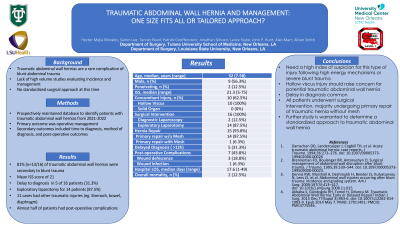Trauma
Category: Quickshot Oral Session 24
Quickshot Oral : Quickshot Oral Session 24
TRAUMATIC ABDOMINAL WALL HERNIA AND MANAGEMENT: ONE SIZE FITS ALL OR TAILORED APPROACH?
Tuesday, February 14, 2023
7:00am - 8:00am East Coast USA Time


Hector Mejia, MD (he/him/his)
Surgery Resident
Tulane University School of Medicine, United States- AS
Alison Smith, MD
United States
Presenter(s)
Principal Contact(s)
Objectives: Traumatic abdominal wall hernias are a rare complication of high energy blunt trauma. There is a lack of high volume studies evaluating the incidence and management of this particular complication due to its rarity. No standardized practice in regards to optimal surgical management and timing for repair of these hernias. The objective of this case series was to evaluate the diagnosis and management of traumatic abdominal wall hernias.
Methods: A prospectively maintained database was used to identify patients with traumatic abdominal wall hernia from 2021-2022. The primary outcome measured was operative management. Secondary outcomes included: time to diagnosis, method of diagnosis, and post-operative outcomes.
Results: Of the 16 patients in this case series, 81% (n=13/16) were secondary to blunt trauma with mean ISS score of 21. Delay to diagnosis was found in 5 of 16 patients. Exploratory laparotomy was performed in 14 cases. Biologic Mesh was used as part of repair in only 1 instance. In 11 cases, there were concomitant traumatic injuries such as injury to stomach, bowel, diaphragm, and visceral vessels. Post-operative complications were frequent in half of the patients with 3 patients experiencing wound dehiscence. Average follow up was 4.2 months.
Conclusion: This case series outlines the incidence of traumatic abdominal wall hernias and their management over a 2 year period at a Level 1 Trauma center. During this period traumatic abdominal hernias were diagnosed in 16 patients again emphasizing the rarity of this complication and variability in presentation. Of note there were 2 instances of traumatic abdominal wall hernias secondary to penetrating injury, which is not often associated with traumatic abdominal hernias. Future studies should be aimed at standardizing management approach taking into account nature of the mechanism and concomitant injuries.
Methods: A prospectively maintained database was used to identify patients with traumatic abdominal wall hernia from 2021-2022. The primary outcome measured was operative management. Secondary outcomes included: time to diagnosis, method of diagnosis, and post-operative outcomes.
Results: Of the 16 patients in this case series, 81% (n=13/16) were secondary to blunt trauma with mean ISS score of 21. Delay to diagnosis was found in 5 of 16 patients. Exploratory laparotomy was performed in 14 cases. Biologic Mesh was used as part of repair in only 1 instance. In 11 cases, there were concomitant traumatic injuries such as injury to stomach, bowel, diaphragm, and visceral vessels. Post-operative complications were frequent in half of the patients with 3 patients experiencing wound dehiscence. Average follow up was 4.2 months.
Conclusion: This case series outlines the incidence of traumatic abdominal wall hernias and their management over a 2 year period at a Level 1 Trauma center. During this period traumatic abdominal hernias were diagnosed in 16 patients again emphasizing the rarity of this complication and variability in presentation. Of note there were 2 instances of traumatic abdominal wall hernias secondary to penetrating injury, which is not often associated with traumatic abdominal hernias. Future studies should be aimed at standardizing management approach taking into account nature of the mechanism and concomitant injuries.

